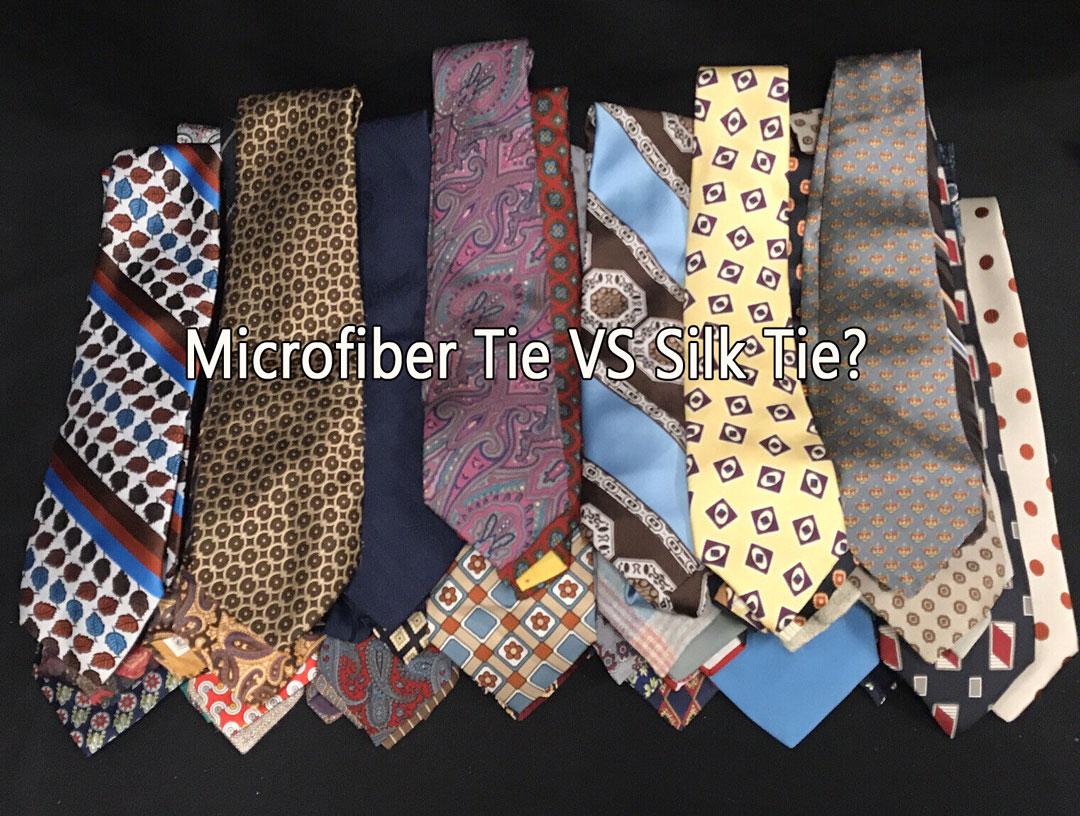
Microfiber or Silk: The Tie Breaker Debate
Definition of Microfiber Tie and Silk Tie
A silk tie is a classic necktie accessory made from natural silk fabrics spun from silkworms' cocoons. Silk has been a favored material for ties due to its delicate texture that exudes luxury, richness, and class. On the other hand, a microfiber tie is made using synthetic fibers that are finer than human hair strands.
Microfiber material may contain polyester or nylon fibers or a blend of both. It's a relatively new material that has gained popularity over time due to its excellent performance as an alternative material for clothing accessories.
Purpose of the Comparison
This article seeks to provide insight into which necktie alternative between microfibers vs. silk yields better quality results when it comes to aesthetics, durability, maintenance requirements (care), pricing affordability (cost), environmental impact (eco-friendliness), availability in stores (supply-chain distribution), design variety (fashion trends), etc.
Thesis Statement
The primary goal of this paper is to compare and contrast two popular materials used in manufacturing neckties: microfiber ties vs. silk ties- examining their features, benefits & drawbacks against each other before concluding on which one stands out as better based on specific criteria factors mentioned above that most customers are likely interested in optimizing when selecting their perfect necktie accessory.
Features of Microfiber Ties
Material Composition
Microfiber ties are made of synthetic fibers, which are usually a blend of polyester and nylon. These fibers are much finer than human hair, making the material lightweight and breathable. The microfibers are tightly woven to create an ultra-smooth texture that feels similar to silk.
Durability
One of the most significant features of microfiber ties is their durability. The synthetic fibers used in their composition make them highly resistant to wear and tear. They can withstand multiple washings without losing their shape or color, making them ideal for everyday use.
Stain Resistance
Another benefit of microfiber ties is their high level of stain resistance. Unlike silk ties, which can easily become stained with even a drop of water, microfiber ties can repel stains from liquids like coffee or wine. This feature makes them a practical choice for those who want a tie that can withstand spills or accidents.
Cost
One of the most attractive features of microfiber ties is their low cost compared to silk ties. They are an affordable alternative to silk without compromising on quality or style.
With a wide range of colors and designs available, they offer excellent value for money and are an excellent option for those on a budget or looking to build up their tie collection without breaking the bank. Overall, the material composition, durability, stain resistance, and affordability make microfiber ties an appealing option for those looking for practical yet stylish accessories that can be worn on any occasion.
Benefits of Microfiber Ties
Easy Maintenance: Keeping it Clean and Crisp
One of the most significant benefits of microfiber ties is their easy maintenance. Unlike silk ties, microfiber ties do not require dry cleaning or any special washing methods. They can be hand-washed or machine-washed with cold water and mild detergent.
After washing, it's recommended to hang them up for air-drying to avoid shrinking or distortion. In addition, they do not require ironing since they are wrinkle-resistant by nature.
Versatility: Suitable for Different Occasions and Outfits
Microfiber ties are known for their versatility as they come in many different colors and patterns that complement various outfits and occasions. They can be paired with formal suits for a business meeting or a wedding reception, as well as with casual outfits like jeans and a blazer for a night out with friends or family.
Availability: Widely Accessible in Different Stores and Online Shops
Unlike silk ties that are usually sold in upscale stores or boutiques, microfiber ties are readily available in many stores at an affordable price range. Many online shops also provide a wide range of choices that cater to different tastes, preferences, and budgets.
Environmental Friendliness: Eco-Friendly Choice
Microfiber ties are an eco-friendly choice compared to silk ties since the manufacturing process involves producing synthetic fibers from recycled materials such as plastic bottles or polyester waste. This process prevents polluting the environment by decreasing the number of plastic waste items sent to landfills. Furthermore, it saves water usage since the production process requires less water than silk tie production does.
Drawbacks of Microfiber Ties
Limited Breathability
One of the significant drawbacks of microfiber ties is their limited breathability. While they are excellent at wicking moisture away from the body, they lack the kind of ventilation that is necessary to keep the wearer comfortable during hot weather. This can lead to sweating and discomfort, especially if the wearer is prone to perspiration.
Moreover, since microfiber ties are made synthetically, they do not allow air circulation as silk does. Thus, an individual might feel suffocated while wearing a microfiber tie in hot and humid weather conditions.
Lack of Luxurious Appearance
While microfiber ties are known for their functionality and durability, they lack that luxurious appearance that silk ties provide. Microfibers tend to be more synthetic in nature and do not give off a natural or organic appearance that silk provides. Although some manufacturers try to mimic silk patterns on microfibers, it does not match up with the natural shine and softness that silk offers.
Limited Variety in Design
Another significant limitation of microfiber ties is their limited variety in design options compared to silk ties. Since it is a relatively newer material used for manufacturing neckties, most manufacturers have not developed enough designs or patterns as they have for traditional materials like silk or cotton-based fabrics.
As a result, individuals interested in unique or diverse designs may find themselves more limited when choosing from a variety of available designs on offer by various brands when opting for microfiber tie alternatives rather than traditional silks. Microfibers' drawbacks may impact whether someone will choose them over traditional materials like silks when selecting neckties for their formal attire events based on personal preferences such as material quality or design variety options available.
Features of Silk Ties
Silk ties are synonymous with luxury and sophistication. They have been a staple in men’s fashion for centuries, and for good reason. In this section, we will explore the main features that set silk ties apart from other materials.
Material Composition
Silk is a natural protein fiber that comes from the cocoon of the silkworm. The fibers are then woven into fabric to create a soft, lustrous material that is perfect for ties. The high-quality silk used in ties is made up of long, continuous fibers that create a smooth and even texture.
Luxurious Appearance
One of the standout features of silk ties is their luxurious appearance. The smooth texture and lustrous sheen make them stand out from other tie materials. Silk has been associated with wealth and luxury for centuries, making it an ideal choice for formal events like weddings or business meetings.
Breathability
Silk is a highly breathable material that keeps you cool on hot days and warm on cold days. It allows air to circulate around your neck while still maintaining its shape, making it comfortable to wear all day long.
Availability
Silk has been used in fashion for centuries, so it's no surprise that it's widely available today. You can find silk ties in just about any color or pattern you can imagine, making them versatile enough to wear with almost any outfit.
The features of silk ties make them an excellent choice for anyone looking to add some luxury and sophistication to their wardrobe. From the natural material composition to their breathability and availability in a wide range of colors and patterns, there are many reasons why silk ties have stood the test of time as one of the most popular tie materials available today.
Benefits of Silk Ties
Silk ties are a popular choice for formal occasions due to their luxurious texture and appearance. However, silk ties also come with various benefits that make them preferable over other types of ties.
Variety in Design
One significant benefit of silk ties is the vast array of designs available. From classic stripes and solids to intricate paisleys and intricate prints, silk ties offer an extensive range of options to complement any outfit. They come in various colors, textures, and patterns that can add a touch of elegance or playfulness to an ensemble.
Durability
Another advantage of silk ties is their durability. Silk fibers are strong and resistant to wear and tear, which makes them perfect for daily use or special occasions such as weddings or business meetings. A well-maintained silk tie can last for years without losing its sheen or shape.
Cultural Significance
Silk has been used in clothing for centuries, particularly in Asian cultures where it is considered a symbol of wealth and prosperity. Wearing a silk tie not only adds elegance but also honors this cultural tradition.
Sophistication
One cannot ignore the sophistication that comes with wearing a silk tie. The texture, shine, and draping qualities all contribute to creating an air of classiness around the wearer.
Whether it's attending a formal event or making a statement at the office, nothing says sophistication like a well-tied silk necktie. Overall, silk ties are an excellent investment due to their variety in design options, durability over time while maintaining their aesthetic appeal - not forgetting their cultural significance which only adds value to this piece - plus they’re both stylish and sophisticated making them ideal for any formal occasion!
Drawbacks of Silk Ties
Silk ties have been a staple in the fashion industry for centuries, but they do come with a few drawbacks. These drawbacks are important to consider when deciding whether or not to invest in a silk tie.
High Cost
One of the biggest drawbacks of silk ties is their high cost. Silk is an expensive material, and therefore, silk ties tend to be more expensive than other types of ties. This can make them less accessible to those who are on a tight budget or who simply do not want to spend a lot of money on a single clothing item.
Difficulty in Maintenance
Silk ties can also be difficult to maintain. They require special care and attention when cleaning, as they cannot be washed in the same way that other types of ties can.
Dry cleaning is often recommended for silk ties, which can add to the overall cost over time. Additionally, silk ties may wrinkle easily, making them difficult to keep looking their best.
Stain Susceptibility
Another drawback of silk ties is their susceptibility to stains. Because silk is a delicate material, it can absorb stains easily and may be difficult or impossible to remove completely. This means that wearing a silk tie can sometimes feel like taking a risk, especially when attending events where spills or accidents are more likely.
Limited Environmental Friendliness
It's worth noting that silk production is not always environmentally sustainable or ethical. Silk comes from silkworms that are often boiled alive in order to extract the fibers from their cocoons. Additionally, many processes involved in producing and dyeing silk fabric can have negative environmental impacts.
For those who prioritize sustainability and ethical production practices, this may be a significant drawback of choosing silk ties over other options. While there are certainly benefits to wearing silk ties, it's important to consider the drawbacks as well.
The high cost, difficulty in maintenance, stain susceptibility, and limited environmental friendliness may make silk ties less appealing to some consumers. As with any clothing purchase, it comes down to personal preference and weighing the various factors at play.
Comparison between Microfiber Tie and Silk Tie
The Look and Feel
Silk ties are known for their luxurious feel and appearance. They have a natural sheen that is hard to replicate.
On the other hand, microfiber ties are engineered to look like silk, but they don't quite have the same texture or sheen. They also tend to be thinner than silk ties, which some people may find less appealing.
Maintenance and Durability
Microfiber ties require less maintenance than silk ties. They are machine washable, whereas silk ties need to be dry cleaned or hand washed with care.
Silk is also more delicate than microfiber, so it's more prone to snagging or tearing. However, silk ties tend to last longer if they are well taken care of.
Cost
Microfiber ties are generally less expensive than silk ties. This is because microfiber is a synthetic material, whereas silk is a natural fiber that requires more processing and effort to produce.
Environmental Impact
Silk has a smaller environmental impact compared to microfiber since it's made from natural fibers, as opposed to synthetic ones that end up in landfills once discarded. However, there are now several manufacturers that produce eco-friendly microfibers using recycled materials.
Conclusion
So which tie is better? It really depends on your personal preferences and needs. If you want a tie with a luxurious look and feel that will last for years with proper care, then silk may be the best choice for you.
However, if you want something that requires less maintenance and costs less while still looking good, then go for a microfiber tie. Ultimately what matters most is how confident you feel wearing your chosen accessory - whether it's made from microfiber or pure Silk!
Post time: Jun-08-2023



















